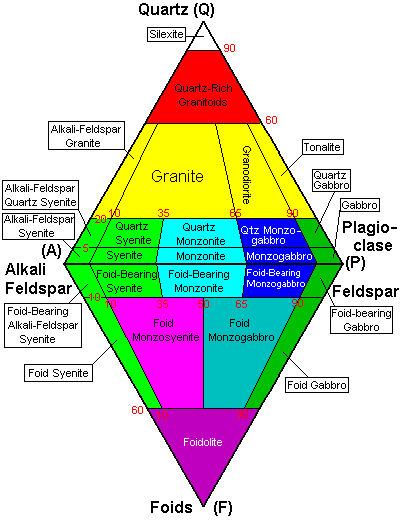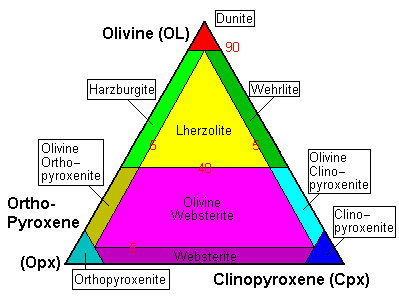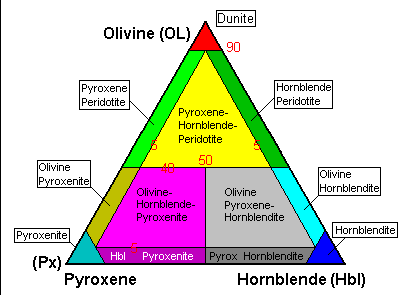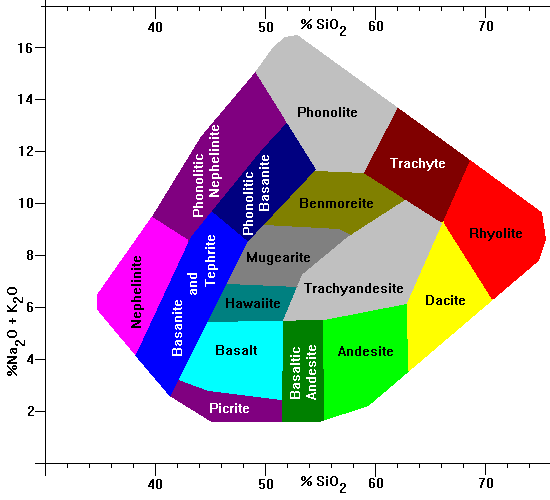Classification of Igneous Rocks
Steven Dutch, Professor Emeritus, Natural and Applied Sciences, Universityof Wisconsin - Green Bay
The most abundant elements in the crust are oxygen, silicon, aluminum, iron, magnesium, calcium, sodium and potassium. These eight elements account for 99 per cent of the crust. Since oxygen is by far the dominant anion, rock compositions are usually reported as oxides rather than as separate elements. Most minerals can be written as combinations of the oxides. For example, K-feldspar (KAlSi3O8) can be written as 1/2(K2O + Al2O3 + 3SiO2)
The most abundant oxide by far is SiO2, so the first question petrologists ask in classifying igneous rocks is how much silica is present? Is there so muchthat after all other minerals are accounted for, silica is left over to form quartz? Or is there so little that silica deficient minerals like olivine, leucite or nepheline arepresent?
Next most abundant oxide is aluminum, which resides principally in feldspars. So the second question petrologists ask in classifying igneous rocks is what feldspars are present? The feldspars largely account not only for Al, but Ca, Na and K as well.
That leaves Mg, Fe and minor constituents. The third question petrologists ask in classifying igneous rocks is what other minerals are present?
As a student, I was puzzled and frustrated that the igneous rocks were classified on the basis of minerals that looked so much alike in thin section. However, to a practiced petrologist, quartz, K-feldspar and plagioclase are quite distinct and easily recognizable.
Apart from accounting for most of the major elements, there's another reason we define igneous rocks in terms of quartz and the feldspars. Relatively minor influences like water content can drastically change the ferromagnesian minerals in a rock. A very anhydrous magma might form the ferromagnesian pyroxene hypersthene. With a bit more water, the otherwise identical magma might form the amphibole actinolite or biotite mica.
Important Classes of Igneous Rocks
The silica and aluminum contents of igneous rocks can be placed in broad classes:
Silica content
- Oversaturated rocks are those with quartz.
- Undersaturated rocks are those with silica-deficient minerals that are incompatible with quartz. These minerals include corundum, olivine, leucite and nepheline.
Aluminum content
- Peraluminous rocks are those with an excess of aluminum, so that after the feldspars form, excess aluminum remains to form aluminum-rich minerals like corundum, andalusite, kyanite, sillimanite, or garnet.
- Peralkaline rocks are those with so little aluminum that sodium or potassium are left over after the feldspars form. The most common indications of peralkaline rocks are the sodium pyroxene aegerine (acmite) and the sodium amphibole riebeckite.
IUGS Igneous rock names
| Oversaturated rocks can be plotted on a triangle diagram with its vertices occupied by quartz, alkali feldspar and plagioclase.
Undersaturated rocks can contain alkali feldspar and plagioclase, but not quartz. Instead they contain minerals like leucite or nepheline. These minerals were once called feldspathoids, a name that aptly describes their "ecological niche" since they perform the role of feldspars but form instead because of insufficient silica. In modern petrological classification, these minerals are termed "foids", a meaningless name that describes nothing. Undersaturated rocks can also be plotted on a triangle diagram with vertices occupied by foids, alkali feldspar and plagioclase. |
|
 |
Since the two triangles have alkali feldspar and plagioclase in common, it is customary to join the two base to base with alkali feldspar and plagioclase along the common edge and quartz and foids at the top and bottom vertices. The two triangles are mutually exclusive. |
| In the diagram here, broad families of rocks (granitic rocks, syenite, gabbro) are shown by common colors.
The term "alkali feldspar" refers to K-feldspar or albite (less than 10% anorthite). These feldspars form a fairly complete solid solution series. Any plagioclase richer than 10% anorthite is considered plagioclase. |
|
Gabbroic Rocks
Rocks with mostly plagioclase are termed gabbro or diorite. There are several subcategories of these rocks.
Rocks with less than 5 per cent ferromagnesian minerals (i.e. mostly made of plagioclase) are termed anorthosite. Rocks with over 40 % ferromagnesian minerals are generally termed gabbro. Rocks with 5-40 percent ferromagnesian minerals are termed diorite if their feldspar consists of less than 50 percent anorthite, or leucogabbro (leuco- is a Greek prefix meaning light or white) if their feldspar consists of more than 50 percent anorthite.
Ultramafic Rocks
 |
Rocks containing more than 90 per cent ferromagnesian minerals are classified on the basis of their dark minerals. If the ferromagnesian minerals consist only of olivine and pyroxene, they are classified on the basis of their contents of olivine, orthopyroxene (usually enstatite or hypersthene) and clinopyroxene (usually augite). Of these rocks, three are especially important. Dunite virtually never forms directly from a dunite melt, but almost always as the result of magmatic segregation. Harzburgite and lherzolite are the dominant rock types of the uppermost mantle. |
 |
If hornblende is present as well, the classification is based on the relative amounts of olivine, pyroxene and amphibole. Rocks consisting of more than 90 percent of any component are termed dunite, pyroxenite or hornblendite, respectively. Rocks consisting of mostly olivine are termed peridotite. (Peridot is the name of a gem variety of olivine.) |
Volcanic Rocks
Volcanic rocks are classified in almost exactly the same way as plutonic rocks. The principal difference is that volcanic rock names are substituted for their plutonic equivalents:
| Plutonic Rock | Volcanic Equivalent |
| Granite | Rhyolite |
| Granodiorite | Dacite |
| Tonalite | Quartz Andesite |
| Syenite | Trachyte |
| Monzonite | Latite |
| Diorite | Andesite |
| Gabbro | Basalt |
| Monzogabbro (or diorite) | Latite-basalt (or andesite) |
Volcanic rocks of extreme foid or ultramafic composition are extremely rare.
LeMaitre Plot
This plot combines silica saturation on the horizontal axis with peraluminous-peralkaline classification on the vertical. It's useful when rocks are too fine-grained for reliable mineral identification, have been metamorphosed, and so on.

Return to Mineralogy-Petrology Index
Return to Thin-Section Index
Return to Crystals and Light Index
Return to Crystal Structures Index
Return to Mineral Identification Tables
Return to Professor Dutch's Home Page
Created November 30,, 1999, Last Update
Not an official UW-Green Bay Site